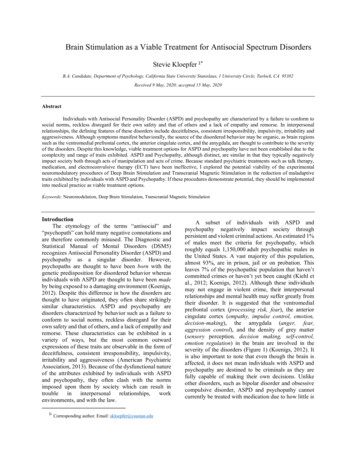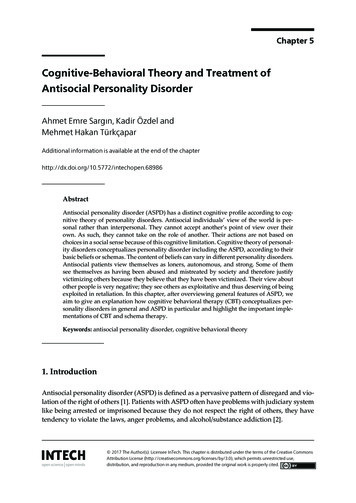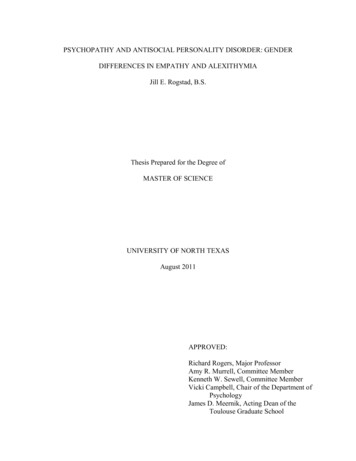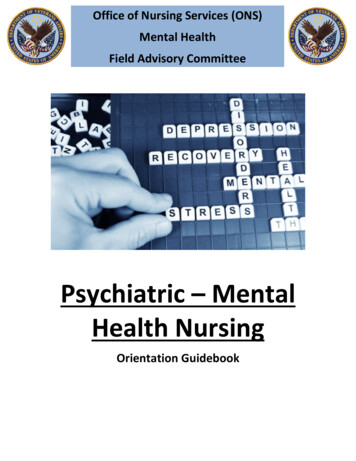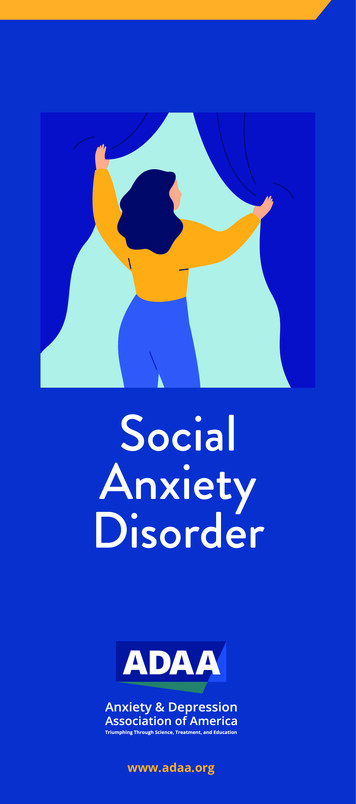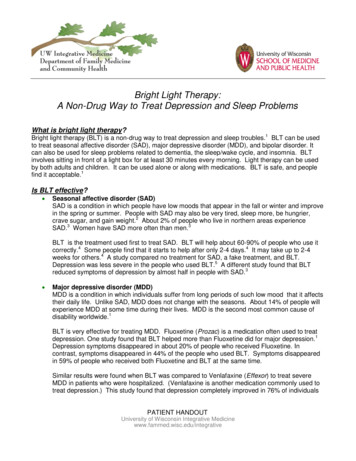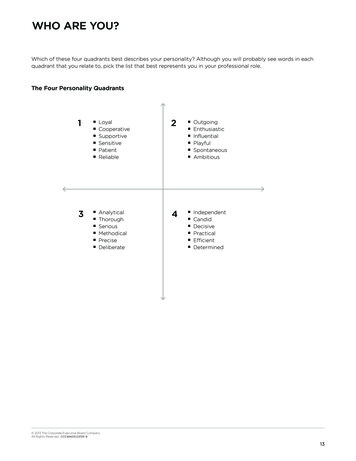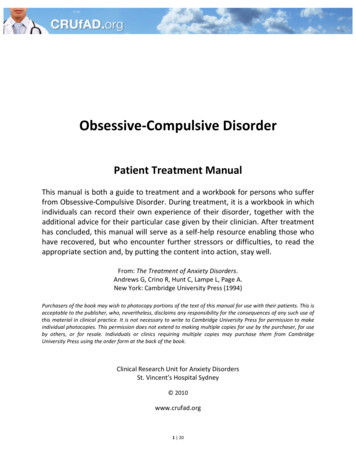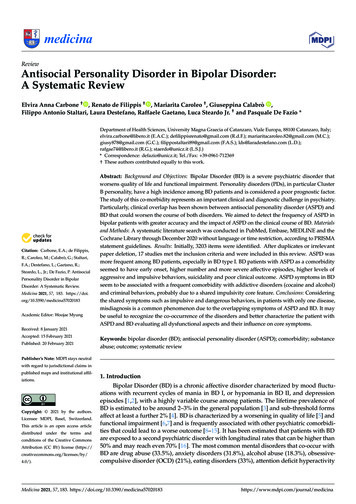
Transcription
medicinaReviewAntisocial Personality Disorder in Bipolar Disorder:A Systematic ReviewElvira Anna Carbone † , Renato de Filippis † , Mariarita Caroleo † , Giuseppina Calabrò ,Filippo Antonio Staltari, Laura Destefano, Raffaele Gaetano, Luca Steardo Jr. † and Pasquale De Fazio *Department of Health Sciences, University Magna Graecia of Catanzaro, Viale Europa, 88100 Catanzaro, Italy;elvira.carbone@libero.it (E.A.C.); defilippisrenato@gmail.com (R.d.F.); mariaritacaroleo.82@gmail.com (M.C.);giusy878@gmail.com (G.C.); filippostaltari89@gmail.com (F.A.S.); lds@laradestefano.com (L.D.);rafgae74@libero.it (R.G.); staerdo@unicz.it (L.S.J.)* Correspondence: defazio@unicz.it; Tel./Fax: 39-0961-712369† These authors contributed equally to this work. Citation: Carbone, E.A.; de Filippis,R.; Caroleo, M.; Calabrò, G.; Staltari,F.A.; Destefano, L.; Gaetano, R.;Steardo, L., Jr.; De Fazio, P. AntisocialPersonality Disorder in BipolarDisorder: A Systematic Review.Medicina 2021, 57, 183. https://doi.org/10.3390/medicina57020183Academic Editor: Woojae MyungAbstract: Background and Objectives: Bipolar Disorder (BD) is a severe psychiatric disorder thatworsens quality of life and functional impairment. Personality disorders (PDs), in particular ClusterB personality, have a high incidence among BD patients and is considered a poor prognostic factor.The study of this co-morbidity represents an important clinical and diagnostic challenge in psychiatry.Particularly, clinical overlap has been shown between antisocial personality disorder (ASPD) andBD that could worsen the course of both disorders. We aimed to detect the frequency of ASPD inbipolar patients with greater accuracy and the impact of ASPD on the clinical course of BD. Materialsand Methods: A systematic literature search was conducted in PubMed, Embase, MEDLINE and theCochrane Library through December 2020 without language or time restriction, according to PRISMAstatement guidelines. Results: Initially, 3203 items were identified. After duplicates or irrelevantpaper deletion, 17 studies met the inclusion criteria and were included in this review. ASPD wasmore frequent among BD patients, especially in BD type I. BD patients with ASPD as a comorbidityseemed to have early onset, higher number and more severe affective episodes, higher levels ofaggressive and impulsive behaviors, suicidality and poor clinical outcome. ASPD symptoms in BDseem to be associated with a frequent comorbidity with addictive disorders (cocaine and alcohol)and criminal behaviors, probably due to a shared impulsivity core feature. Conclusions: Consideringthe shared symptoms such as impulsive and dangerous behaviors, in patients with only one disease,misdiagnosis is a common phenomenon due to the overlapping symptoms of ASPD and BD. It maybe useful to recognize the co-occurrence of the disorders and better characterize the patient withASPD and BD evaluating all dysfunctional aspects and their influence on core symptoms.Received: 8 January 2021Accepted: 15 February 2021Published: 20 February 2021Keywords: bipolar disorder (BD); antisocial personality disorder (ASPD); comorbidity; substanceabuse; outcome; systematic reviewPublisher’s Note: MDPI stays neutralwith regard to jurisdictional claims inpublished maps and institutional affiliations.Copyright: 2021 by the authors.Licensee MDPI, Basel, Switzerland.This article is an open access articledistributed under the terms andconditions of the Creative CommonsAttribution (CC BY) license (https://creativecommons.org/licenses/by/4.0/).1. IntroductionBipolar Disorder (BD) is a chronic affective disorder characterized by mood fluctuations with recurrent cycles of mania in BD I, or hypomania in BD II, and depressionepisodes [1,2], with a highly variable course among patients. The lifetime prevalence ofBD is estimated to be around 2–3% in the general population [3] and sub-threshold formsaffect at least a further 2% [4]. BD is characterized by a worsening in quality of life [5] andfunctional impairment [6,7] and is frequently associated with other psychiatric comorbidities that could lead to a worse outcome [8–15]. It has been estimated that patients with BDare exposed to a second psychiatric disorder with longitudinal rates that can be higher than50% and may reach even 70% [16]. The most common mental disorders that co-occur withBD are drug abuse (33.5%), anxiety disorders (31.8%), alcohol abuse (18.3%), obsessivecompulsive disorder (OCD) (21%), eating disorders (33%), attention deficit hyperactivityMedicina 2021, 57, 183. w.mdpi.com/journal/medicina
Medicina 2021, 57, 1832 of 15disorder (ADHD) (25%), and post-traumatic stress disorder (PTSD) (from 4 to 40%) [17–23].In addition, particularly high is the incidences of cluster B personality disorders in BD thatare estimated at 41.2% even in the euthymic phase [24] and, represent a poor prognosticfactor [25–28]. The study of this co-morbidity represents an important clinical and diagnostic challenge in psychiatry. Furthermore, Cluster B personality disorders have severalcommon features with BD such as impulsivity, aggressive behavior, and mood instability,enough to induce some authors to consider them part of the bipolar spectrum [29]. Instead,features associated with Cluster B personality disorders may be a dimensional aspect of BD,and when combined could result in greater complexity and severity of the disease [30,31].Conversely, the presence of BD could worsen the course of a personality disorder [32].Several studies have shown that the presence of cluster B personality in BD is associatedwith a higher number of episodes, substance abuse, illegal behavior, a higher rate of suiciderisk, and a poor treatment adherence [32–34]. In this scenario, researchers have focused onthe impact of personality disorder on BD, investigating the common traits that mutuallylead to a worse outcome [34]. Particularly, the clinical overlap has been shown betweenantisocial personality disorder (ASPD) and BD.According to the DSM-5, the ASPD is described as the existence of constant andpervasive disposition to disregard and disrupt the rights of others. Other specific featuresinclude frequent violations of the law, mistreatment of others, deceitfulness, impulsivity,hostility, reckless disregard for the safety of self and others, and imprudent behaviors withlack of guilt, remorse, and empathy [35].In fact, the prevalence of ASPD can be up to five times higher (4.1%) [36] and appearsto be more frequently identified in BD I than BD II [37]. ASPD and BD are both characterized by impulsive behaviors [38,39] and substance use disorder [40–42] that frequently leadto trouble with the law [43,44] and suicidal behavior [45,46]. Studies suggested that impulsivity and the frequent abuse of drugs, especially alcohol, cannabis and amphetamines,is associated with sensation seeking and a lack of premeditation in ASPD and that whenASPD is co-morbid with BD it is associated with significant deficits in the ability to delayreward [47–49] and greater gray matter volume in the mesolimbic reward system [50].These characteristics appear more severe when they are combined [50–52] and a more indepth characterization of ASPD comorbidity in patients with BD may help clinicians to distinguish both disorders and tailor the treatment. Thus, in an attempt to detect the frequencyof ASPD in bipolar patients with greater accuracy and to better clarify the relationshipbetween ASPD and BD, we conducted a systematic review of the existing literature on thefrequency of ASPD in BD I, BD II and cyclothymia, according to DSM or ICD diagnosticcriteria, evaluating the impact on clinical characteristics and outcomes.2. Materials and Methods2.1. Search StrategyWe searched PubMed, Embase, MEDLINE, and the Cochrane Library for articlesevaluating the comorbidity between BDs and ASPD published up to 1 December 2020.No language or time restriction were applied. We used the following keywords: “bipolardisorder OR affective disorder OR mood disorder OR bipolar disorders OR affective disorders ORmood disorders OR BD OR cyclothymia AND antisocial personality disorder OR ASPD OR AABSOR adult antisocial behavior syndrome OR antisocial behavioral syndrome” sorted by best match.Two researchers independently reviewed all the selected studies. Titles and abstracts of theidentified papers were reviewed, and full texts considered relevant were recovered andrevised. The reference lists of eligible studies were also hand-screened to search additionaland useful studies to be included in the review. To improve the clarity of the review process,the PRISMA Statement criteria and recommendations were followed [53]. Figure 1 showsthe research strategy.
Medicina2021,Medicina2021,57, 57,183183of 153 of317Figure1. ThePRISMAflowchart.Figure1. ThePRISMAflowchart.Assessmentof StudyQuality2.2.2.2.Assessmentof StudyQualityQualityassessmentwaswas conductedMixedMethodsAppraisalTool (MMAT)Qualityassessmentconducted usingusingthetheMixedMethodsAppraisalTooldeveloped by Pluye et al. [54]. Piloting suggested that the MMAT was a reliable and(MMAT) developed by Pluye et al. [54]. Piloting suggested that the MMAT was a reliableefficient scoring system for appraising the quality of quantitative, qualitative, and mixedand efficient scoring system for appraising the quality of quantitative, qualitative, andmethod studies. It provides a comprehensive manual with detailed instructions. Themixed-method studies. It provides a comprehensive manual with detailed instructions.methodology was evaluated using five criteria: qualitative, randomized controlled, nonThe methodology was evaluated using five criteria: qualitative, randomized controlled,randomized, observational descriptive, mixed methods [55]. For each study, a score ofnon-randomized, observational descriptive, mixed methods [55]. For each study, a score20% was assigned if a criterion was met and 100% if all criteria were met, therefore theof 20% was assigned if a criterion was met and 100% if all criteria were met, therefore thetotal score could range between 20 and 100%. Studies were assigned quality scores by twototal score could range between 20 and 100%. Studies were assigned quality scores by tworeviewers (E.A.C. and R.d.F.); scores ranged from 80% to 100%. The quality assessmentreviewers (E.A.C. and R.d.F.); scores ranged from 80% to 100%. The quality assessmentwas finally reviewed and agreed upon the whole review team.was finally reviewed and agreed upon the whole review team.2.3. Selection Criteria2.3. Selection CriteriaOriginal articles were reviewed and reported. Relevant publications were ntpublicationsidentified,andthe fulltexts wereof thesearticlesandwereretrievedand reviewed.Thewerereferencelists ofandincludedthe full textsof thesewere retrievedreviewed.Theliterature.reference Studieslists of instudieswere articlesalso screenedin orderandto searchusefulwithcludedstudieswere alsoscreenedto search ithBD I, BDinIIorderor cyclothymiaand ASPDaccordingto SPDaccordingtoDSMorICDcriteria, regardless of the phase of the disorder and/or pharmacological treatment, agedcriteria,of thephasethe (we sorderstreatment,are not diagnosed18–65(we sordersare not withdiag-BDin childhood)werestudiesincludedthe review article.with patientsdiagnosednosedinIIchildhood)were includedin youngerthe reviewarticle.StudiesI, BDor cyclothymiaand ASPD,than18 andolderwiththanpatients65, withdiagnosedneurologicalwithBD I, BD II or cyclothymiaandinjuriesASPD, younger18 and older thanwith neu-Wecomorbidity,traumatic brainwith lossthanof or concerningtraumatic braininjurieswith lossofofASPDconsciousnesswere exconsideredthe studiesthe lifetimeprevalencein BD.cluded. We considered the studies concerning the lifetime prevalence of ASPD in BD.2.4. Data Collection and Extraction2.4. DataTwoCollectionand Extractionblind researchers(E.A.C. and R.d.F.) independently screened the titles and abstractsoftheidentifiedarticlesand R.d.F.)performeddata extraction.ArticlesthatmetTwo blind researchers (E.A.C. andindependentlyscreenedthe acts of the identified articles and performed data extraction. Articles that met the eligidiscrepancies,a criteria wereread researcherin the full (M.C.)texts, andin thecasesof calesdiscrepancies, a third researcher (M.C.) made the final decision. Article data included first ofmeasurement and statistical data.
Medicina 2021, 57, 1834 of 153. ResultsInitially, 3203 items were identified. After deletion of duplicates (226) by two reviewers(E.A.C., R.d.F.), 2977 papers remained. Exclusion of papers by title and abstract was madeby two reviewers (E.A.C., R.d.F.) based on assessment of the inclusion and exclusion criteria.This process ended in the exclusion of 2751 papers. The title and abstracts screening wasperformed for the remaining 226 articles. In all, we excluded 201 articles because they werereviews, meta-analyses, letters to editors, editorials, guidelines, and case reports. Someof them had only a bipolar subgroup or other personality disorder as a comorbidity, orthe diagnosis was not clear. Then, 8 manuscripts out of 25 papers were deleted becausethey did not fulfill the inclusion criteria: 5 papers included patients aged 18 or 65, and3 papers had unclear diagnosis focusing on personality disorders and not specifying thediagnosis. The remaining 17 papers were deemed eligible and included in the presentreview (Table 1). A great heterogeneity was reported among studies included and widevariability in the sample number (from N 21 to N 43,093) [49,56]. ASPD prevalence inBD ranged between 4.8% and 63% [47,57] and was higher in BD I [37] than II [17,49,58]and, in particular, in BD patients with substance use disorder (SUD) comorbid [47–49] withcombined cocaine and alcohol abuse was most frequent [48,49,59]. Patients with BD andASPD in comorbidity showed early onset [58], a higher number of depressive and manicepisodes [47], higher scores of depression [59] and psychosis [47], more aggressive [60],and impulsive [47,61] traits and more suicide attempts [47]. The psychometric tools usedto assess the psychopathology were the Alcohol Use Disorder and Associated DisabilitiesInterview Schedule (AUDADIS) [49,57], the 12-Item Short Form Survey (SF-12) [49,57], theBarratt Impulsiveness Scale (BIS-11) [47,58], the Temperament Evaluation of Memphis, Pisa,Paris and San Diego-auto-questionnaire version (TEMPS-A) [62], Hamilton DepressionRating Scale (HDRS) [60,63], Young mania rating scale (YMRS) [60,63], Brown–GoodwinAggression Scale (BGA) [60], and the Schedule for Affective Disorders and Schizophrenia(SADS-C) [47,63].
Medicina 2021, 57, 1835 of 15Table 1. The main characteristics of the included studies.Authors, YearsGoldstein et al., 2017 [57]SampleN 36,309MeasurementsResultsAUDADIS-5; SF-12Lifetime prevalence: ASPD BD1: 11.8%AABS BD1: 4.8%OR (C.I.) lifetime of BD 1 comorbidity:ASPD 2.9 (1.93–4.28) AABS 1.9 (1.43–2.50)Lev-Ran et al., 2013 [49]N 43,093AUDADIS-IV; SF-12Swann et al., 2013 [58]N 554 BD II51 BD I14 no Axis II disorder (8 menand 6 women)35 ASPD (20men and 15 women)23 Borderline 8men and 15 women17 (7 men and10 women) both disordersDiagnosis was made byStructured Clinical Interviewfor DSM-IVSCID-IISchedule for AffectiveDisorders and Schizophrenia(SADS-C)Barratt Impulsiveness Scale(BIS-11)N 103SCID-II; Time-lineFollow-back Calendar; AUS;DUS; SATS; BPRS; GAS;Knowledge Test; SPSI; FAS;SF-12; FEISMueser et al., 2012 [59]12-month prevalence: BD CUD ASPD:49.9% BD No CUD ASPD: 18.2%OR (C.I.):2.75 (1.63–4.64)Prevalence:35 ASPD of 55 BD:63%17 ASPD Borderline of 55: 30.9%.Number of episodes: ASPD symptomspredicted a history of many depressiveand manic episodes (but not either typealone) and a early onset.BIS-11 score:Total, motor, and attentional BIS-11 scoreswere predicted significantly by borderlinesymptom scores with no significantcontribution from ASPD scores. Suicideattempts: Impulsivity in ASPD BD didnot contribute significantly to history ofsuicide attemptSUD Comorbidity:ASPD symptoms predicted history ofalcohol, other substance-abuse disorder,and smoking.Prevalence:21 ASPD of which 11 BD: 52%CommentsComorbidity is higher in theASPD than in the AABS. Patientswith ASPD has a 3 times fold riskof BD, while it is 2 times greaterif it has AABSThe bipolar patient with CUD isalmost 3 times more likely tohave ASPD than the bipolarpatient without CUDMMAT**********ASPD symptoms were morestrongly related to course ofillness (i.e., early age at onset,frequency of affective episodes,suicide attempts andsubstance-related disorders) butnot to impulsivity.****Over half of the antisocialpatients are also bipolar*****
Medicina 2021, 57, 1836 of 15Table 1. Cont.Authors, YearsSampleMeasurementsResultsPerugi et al., 2012 [62]N 106CGI-BP; TEMPS-A; SAS;IPSM; SIMD-RPrevalence:BD I ASPD: 8.49%Swann et al., 2011 [61]N 13346 HC21 BD without personalitydisorders50ASPD without BD16BD ASPDGoldstein et al., 2010 [17]N 2442Swann et al., 2010 [47]N 19778 HC34 ASPD61 BD24 BD ASPDImmediate Memory Task(IMT)Two Choice ImpulsivityParadigm (TCIP)AUDADIS-IVSCID-II; SADS-C; BIS-11Prevalence:16 ASPD of 37 BD: 43.24%Impulsivity:Impulsivity was increased in thecombined disorders compared to bothdisorders alone.Outcome:In combined ASPD and BD increasedreaction speed, impulsive response bias,and reward- delay impulsivity occurred. Itwas independent of substance-usedisorder history.Prevalence:BD1 ASPD: 45.1% (p 0.0001) BD2 ASPD: 8.2% (p 0.0122)BD1 AABS:32.4%BD2 AABS: 5.8%Prevalence:12.4% of total sampleSADS-C score:Higher scores of depression and psychosisBIS-11 score:higher subscale and total scoreSuicide attempts:BD ASPD: 65.4%BD: 34.9%SUD Comorbidity:BD ASPD: 91.3%BD: 66.7%Number of episodes:Higher number of manic and depressiveepisodesCommentsThe authors evaluated the impactof the affective phase of BD1 onaxis II diagnosis, concluding thatASPD is more represented amonghyperthymic than cyclothymic,depressive or euthymic patientsand affective temperaments mayinfluence both clinical featuresand axis I and II comorbidities.MMAT****The combination of ASPD andBD was associated with moreimpulsive TCIP performancecompared to HC. Compensatorymechanisms for impulsivity inuncomplicated ASPD or BDappear to be compromised or lostwhen the disorders are incomorbidity.****In subjects with PTSD and ASPD,comorbidity with DB 1 is thestrongest evidence, that with DB2, although lower, however, isstatistically significant.*****Comorbidity is associated with agreater tendency to depressionand psychosis, an increasednumber of depressive and manicepisodes, greater impulsivity,greater risk of SUD and suicide.****
Medicina 2021, 57, 1837 of 15Table 1. Cont.Authors, YearsGarno et al., 2008 [60]SampleN 10073 BD127 BD2MeasurementsSCID-I; SCID-II; HDRS;YMRS; CTQ; BGAResultsPrevalence DB ASPD: 6.25%Comorbidity and BGA:Higher BGA total score (p 0.008)PrevalenceASPD in BD SUD%; OR (C.I.):BD COCA: 52.8%; 1.86 (0.81–4.26)BD COCA ALCOL:60%; 2.50(1.23–5.08)Prevalence DB ASPD: 6%SUD Comorbidity:SUD BD: 28.6%.Comorbidity: prevalence of antisocialpersonality disorders BD: 28.6%Mitchell et al., 2007 [48]N 166MINIMaina et al., 2007 [19]N 204 BD 21BD I 4; BD II 17BD ASPD 6Yale-BrownObsessive-Compulsive Scale(Y-BOCS); SCID-I; SCID-II;Mueser et al., 2006 [64]N 178SCID-I; SCID- II; BPRS; GAS;TLFB; ASI; AUS; DUS; SATSPrevalence BD AABS: 21.2%Prevalence BD ASPD: 21.1%Garno et al., 2005 [63]N 10073 BD127 BD2SCID-I; SCID-II; CTQ; YMRS;HAM-D; SADS-CPrevalence BD ASPD: 6%Mueser et al., 1999 [65]No ASPD/CD 293CD Only 293Adult ASPD Only 293Full ASPD 293Schizophrenia (28%),schizoaffective disorder (24%),bipolar disorder (22%), majordepression. (19%) and other(7%)SCID; MMS; CRS; MAST;DAST; CAGE; TACE;TWEAK; ACI; AUDIT.PrevalenceBD Adult ASPD Only: 24%Prevalence BD Full ASPD: 22%SUD Comorbidity:Full ASPD group had the highest rate ofsubstance use disorder, followed by eitherthe CD Only or Adult ASPD Only groups,with the No ASPD/CD group lowestCommentsMMATBipolar patients with ASPD havemore aggressive traits****ASPD is more associated with thebipolar group with cocainedependence (almost twice therisk) or cocaine plus alcohol(twice and a half risk)Clinically relevant effects ofcomorbid BD on the personalityfeatures of OCD patients. Ahigher rate of narcissistic andASPD in BD/OCD patients.The prevalence of AABS andASPD in the DB issuperimposableThere is no statisticallysignificant correlation betweenYMRS and HAM-D scores withASPD.Childhood CD and adult ASPDrepresent independentlysignificant risk factors forsubstance use disorders inpatients with schizophreniaspectrum and major affectivedisorders.********************
Medicina 2021, 57, 1838 of 15Table 1. Cont.Authors, YearsJackson & Pica, 1993 [66]Sample112 psychiatric inpatients11 antisocial personalitydisorder, 65 had other forms ofpersonality disorders, 36 nopersonality disorder.35 recent-onset schizophrenicpatients (27 men, 6 women), 26recent-onset bipolar disorderpatients (14 men, 12 women),30 unipolar affective disorderpatients (14 men, 16 women),and 21 (11 men, 10 women)with mixed disorders (e.g.,anorexia nervosa, substanceabuse, somatoform disorders)MeasurementsResultsCommentsMMATSCID, Royal ParkMultidiagnostic Instrumentfor Psychoses, SAPS, SANS,BDI BRMSPrevalence:4 patients of 11 antisocial are affected byBD.Patients with ASPD wereyounger, with lower level ofeducation and higher levels ofmany dysfunctional behaviors, asdelinquency, sexual intercourse,drink/drugs abuse, thefts,vandalism, inconsistent work,irritability/aggressive,impulsivity, recklessness,continual antisocial behaviorthan patients with other or nonePDs.****Narcissistic and Antisocialpersonality disorders were themost prevalent disorders in thissample of Bipolar disorderedpatients, followed by Histrionicand Passive-Aggressive disorders****Patients with BD showed a highfrequency of PDs.****Turley et al., 1992 [56]21 recent onset BD(12 man and 9 women)MCMI-II); SIDP; BDI; SAPS;BRMS; SCID-PThe overall ratio of personality disordersidentified was virtually equivalent for theMCMI- I1 and the SIDP. However, theMCMI-I1 was far more likely to makemultiple diagnoses than the SIDP. TheMCMI-I1 identified a total of 52personality disorders compared with30 for the SIDP.Pica et al., 1990 [67]N 2616 BD10 Schizoaffective DisorderSIDP; SCID-P; RPMIP; BDI;BRMS; SAPS; SANSPrevalenceBD ASPD: 15.39%MMAT scores: ***** 100%; **** 80%; *** 60%; ** 40%; * 20%. AABS: Adult Antisocial behavioral syndrome; ACI: Alcohol Clinical Index; ASI: Addiction Severity Index; ASPD: Antisocial personality disorder;AUDADIS: Alcohol Use Disorder and Associated Disabilities Interview Schedule; AUDIT: Alcohol Use Disorder Identification Test- Clinical Procedure; AUS: Alcol Use Scale; BD: Bipolar Disorder; BDI: BeckDepression Inventory; BGAS: Brown-Goodwin Aggression Scale; BIS-11: Barratt Impulsivity Scale; BPRS: Brief Psychiatric Rating Scale; BRMS: Bech-Rafaelsen Mania Scale; CAGE: Cut Down on Drinking,Annoyed, Guilt and Eye-opener Test; CGI-BP: Clinical Global Impression-BP; CTQ: Childhood Trauma Questionnaire; C.I.: Confidence Interval; CRS: Clinician Rating Scales; CUD: Cannabis Use Disorder; DAST:Drug Abuse Screening Test; DUS: Drugs Use Scale; FAS: Family Attitude Scale; FEIS: Family Experiences Interview Schedule; GAS: Global Assessment Scale; HC: Healthy Control; HDRS: Hamilton. DepressionRating Scale; IMT: Immediate Memory Task; IPSM: Interpersonal Sensitivity Measure; MAST: Michigan Alcohol Screening Test; MCMI-II: Millon Clinical Multiaxial Inventory; MINI: Mini InternationalNeuropsychiatric Interview; MMAT: mixed-method appraisal tool; MMS: Mini- Mental State; OCD: obsessive-compulsive disorder; OR: Odd Ratio; OR: adjusted Odd Ratio; PTSD: Post-Traumatic StressDisorder; RPMIP: Royal Park Multi- Diagnostic Instrument for Psychosis; SADS: Schedule for Affective Disorders and Schizophrenia; SANS: Scale for the Assessment of Negative Symptoms; SAPS: Scale for theAssessment of Positive Symptoms; SASI: Separation Anxiety Symptom Inventory; SATS: Substance Abuse Treatment Scale; SCID- I:Structured Clinical Interview for DSM-IV Axis I Disorders; SCID-P: StructuredClinical Interview for Personality Disorders; SCID-II: Structured Clinical Interview for DSM-IV Axis II Disorders;SF-12: 12-Item Short Form Health Survey; SIDP: Structured Interview for DSM-III personality;SIMD-R: Semi-structured interview for Mood Disorder; SPSI: Social Problem Solving Inventory; SUD: Substances Use Disorder; TACE: Tolerance, Annoyed, Cut Down, and Eye- opener Test; TCIP: Two ChoiceImpulsivity Paradigm; TEMPS-A: Temperament Evaluation of Memphis, Pisa, Paris and San Diego scale; TLFB: Time-line Follow-back; TWEAK: Tolerance, Worry, Eye-opener, Amnesia and Cut Down ondrinking Test; YMRS: Young Mania Rating Scale.
Medicina 2021, 57, 1839 of 154. DiscussionTo the authors’ knowledge, this is the first systematic review that assessed the association and the impact of ASPD and BD. It is worth mentioning how scarce the studiesare that evaluate this association despite the high clinical relevance. The literature demonstrated a high incidence of Axis II personality disorders in patients with DB [24,68] andthe more frequent were Cluster B personality disorders [19,25–27,69] followed by C andA [17,47,58,67]. Antisocial personality disorders [59] together with narcissistic [19,70] andhistrionic personality disorder were diagnosed most frequently in BD patients, even inrecent-onset BD patients [56]. Pica et al., found that 62% of BD patients had PDs and ASPDwas present in 15–39% [67]. Moreover, as can be seen from the studies, a prevalence of 30%ASPD in BD was reported, with a superior incidence in BD I than in BD II. A greater occurrence of antisocial behavior [29] and greater impulsivity during episodes, especially duringmania has been demonstrated [52]. The clinical severity due to the co-occurrence of thetwo disorders and therefore the greater demand for access to clinical services could explainthis higher prevalence. This great variability found in this review (4.8% to 63% [47,57]) maybe due to the variable sample size and population selected of included studies (from N 21to N 43,093) [49,56], the retrospective nature of the included studies, the methodologicaldifferences (e.g., instruments used, phase of the disorder at the time collection) that maynegatively affect the ability to discriminate between ASPD and BD diagnoses due to thehigh prevalence of BD in the general population and the lack of a precise tool for ASPDdiagnostic assessment.As expected, ASPD in comorbidity with BD is associated with a more severe course ofillness and poor responsiveness and adherence to treatment [71,72]. ASPD in BD patientswas associated with a poor outcome after a manic episode [73], a higher rate of suicideattempts [63,74], and a worse course of illness [75], with greater service admission [76].Moreover, the greatest number of depressive events associated with the comorbidity withPDs results in a reduction in the quality of life, and since this is the most frequent suicideattempt during depressive phases, this may explain why patients with comorbidity alsohave a greater tendency to attempt suicide [77]. Patients with BD and ASPD showed anearlier onset of affective symptomatology [58], higher psychopathological burden [58,63],and a higher number of affective episodes [47]. An earlier age at onset of the antisocialbehavior has been also described [32] that often persists in adulthood [78]. Notably,earlier onset is associated with a poorer prognosis in both disorders [79,80], probablydue not only to the genetic contribution [81,82] but also to the environmental influences(e.g., child maltreatment, abuse, violence, harsh and inconsistent parental discipline, andlower quality caregiving) [83,84]. These patients have been also found to have a higherscore of aggressivity measured with the BGA [60], higher impulsivity measured by theBIS-11 [47,58,61], and more suicide attempts [47]. Manic episodes can more easily lead tocriminal penalties, illegal conduct therefore indirectly impacts treatment adherence [85].Low treatment rates were found in patients with ASPD [57] and reflect affected individuals’lack of insight into the seriousness of their problem and consequently lack of effectiveinterventions. Even if BD demonstrated a higher rate of treatment compared to patientsaffected by ASPD, the co-occurrence of two disorders, often in younger patients, mayinterfere with treatment, as well as the ability to adhere to the treatment, with consequentpoor outcome [59].ASPD symptoms were associated with a history of alcohol or other SUDs as wellas smoking. Substance abuse before 15 years is strongly related to ASPD [64,86] andASPD symptoms were related to age at BD onset independently of gender [58]. Lev-Ranand colleagues estimated the 12-month prevalence of BD, SUD (cannabis), and ASPD as49.9%, compared to 18.2% of patients with BD and without SUD [49]. Studies describedcocaine and alcohol combined abuse as most frequent in BD and ASPD [48,49]. A moresevere course of illness was found in comorbid SUD in bipolar patients, including anearlier onset, more rapid progressi
Antisocial Personality Disorder in Bipolar Disorder: . criteria, regardless of the phase of the disorder and/or pharmacological treatment, aged 18. 65 (we excluded studies on adolescents because personality disorders are not diag-nosed in childhood) were includ


